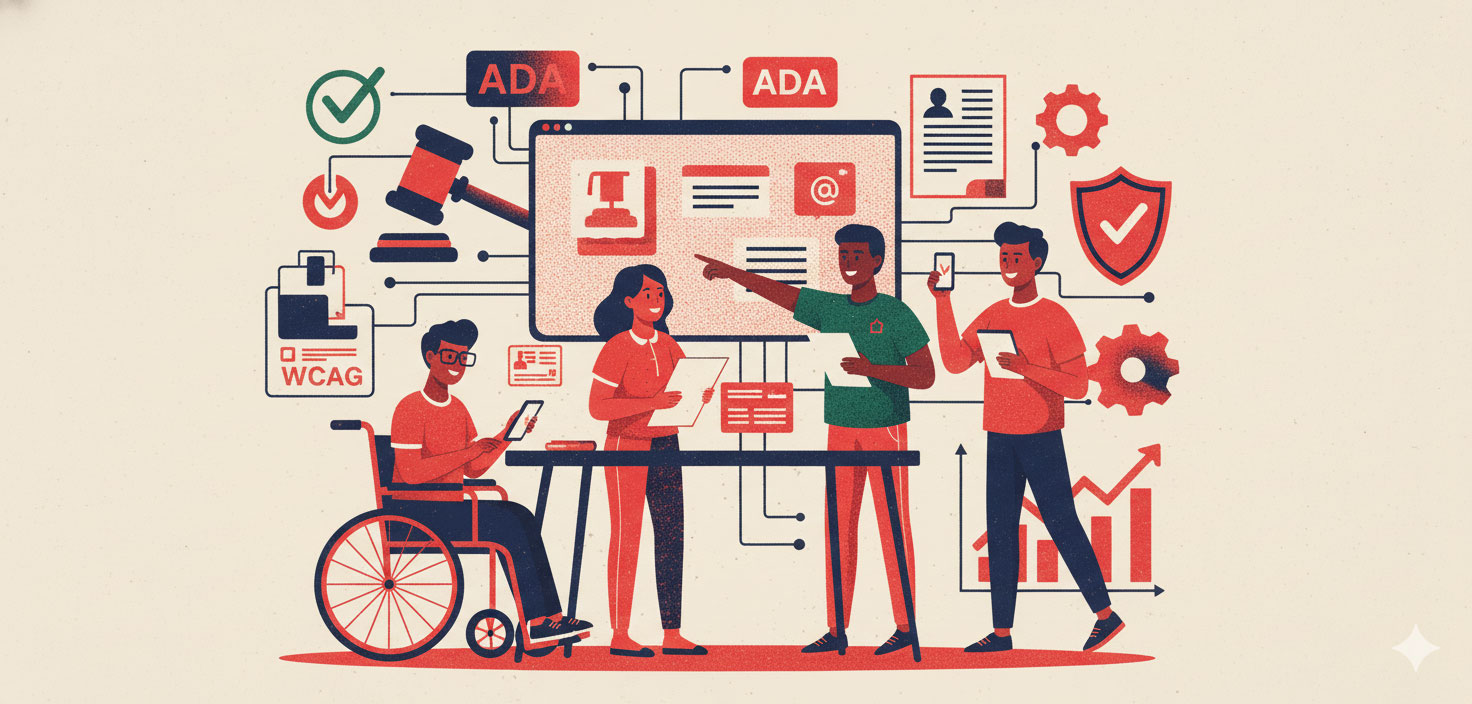Understanding Accessibility in UX/UI Design
What Does Accessibility Mean in Digital Design?
Accessibility in UX/UI design refers to creating digital products—websites, apps, and interfaces—that everyone can use, including people with disabilities. Disabilities can range from visual impairments (like color blindness or low vision) to motor, auditory, cognitive, or speech challenges. When a design is accessible, it ensures equal access to information and functionality for all users—without barriers.
Accessibility isn’t just a feature—it’s a fundamental principle of good design. It ensures that every person, regardless of ability, can perceive, understand, navigate, and interact with a product effectively.
The Relationship Between UX, UI, and Accessibility
UX (User Experience) and UI (User Interface) work hand-in-hand to deliver intuitive and enjoyable experiences. Accessibility bridges the two by ensuring that both the experience and interface are usable by everyone. For example, an accessible UI might include high-contrast colors, readable typography, and screen reader compatibility, while UX considerations ensure logical navigation and clear content hierarchy.
The Evolution of Accessibility Standards
Accessibility design isn’t new. The World Wide Web Consortium (W3C) introduced Web Content Accessibility Guidelines (WCAG) decades ago, setting the foundation for inclusive digital experiences. Today, standards continue to evolve—reflecting advances in assistive technologies like voice commands, screen readers, and AI-based accessibility tools.
Why Accessibility in UX/UI Design Is So Important
Ethical and Human-Centered Design
At its core, accessibility is about empathy. It’s about recognizing that people experience the digital world differently and that it’s our responsibility as designers to remove barriers. By integrating accessibility, you’re committing to inclusivity—making digital spaces welcoming for everyone.
Expanding User Reach and Market Potential
More than 1 billion people worldwide live with a disability, according to the World Health Organization. Ignoring accessibility means excluding a significant portion of your potential audience. Accessible design not only reaches more users but also increases engagement and retention.
Enhancing Usability for All Users
Accessibility often leads to better usability for everyone. Captions help those in noisy environments, large buttons assist users on mobile devices, and clear navigation benefits older users. Simply put, designing for accessibility improves the experience for all users, not just those with disabilities.
Improving SEO and Brand Reputation
Search engines like Google prioritize accessible websites. Features such as alt text, semantic structure, and fast load times all improve SEO rankings. Moreover, brands known for inclusive design build stronger reputations, attract loyal customers, and demonstrate social responsibility.
Key Principles of Accessible UX/UI Design
Perceivable: Designing for All Senses
Information must be presented in ways users can perceive—visually, audibly, or through touch. Designers can achieve this through strong color contrast, text alternatives for images, and captions for videos.

Operable: Ensuring Easy Navigation and Control
Interfaces should be usable with a keyboard, mouse, or assistive device. Avoid time limits, ensure focus indicators are visible, and provide intuitive navigation for all input methods.
Understandable: Making Interfaces Clear and Predictable
Consistency in layout, simple language, and clear instructions help users understand and interact with interfaces effectively. Predictability reduces cognitive load and prevents confusion.
Robust: Compatibility Across Devices and Assistive Technologies
Accessible products must work across various platforms, browsers, and devices. Developers should use semantic HTML and ARIA roles to ensure compatibility with screen readers and assistive technologies.
Practical Ways to Implement Accessibility in UX/UI
Color Contrast and Readability
Maintain at least a 4.5:1 color contrast ratio between text and background. Use accessible typography with sufficient size and spacing to ensure readability.
Keyboard Navigation and Focus States
Ensure all interactive elements—buttons, links, and forms—are navigable via keyboard. Use clear focus states to indicate where users are on a page.
Alt Text, ARIA Labels, and Semantic HTML
Provide descriptive alt text for images and use ARIA labels for dynamic elements. Proper HTML structure helps assistive devices interpret content correctly.
Testing Accessibility: Tools and Methods
Use accessibility testing tools like WAVE, axe, or Lighthouse. Pair automated testing with manual reviews, involving real users with disabilities to ensure genuine usability.
Common Accessibility Mistakes Designers Make
Ignoring Contrast Ratios and Color Blindness
Using low-contrast color schemes or relying solely on color to convey information excludes users with visual impairments.
Over-Reliance on Visual Cues
Designs that depend only on visuals—like icons without text—can confuse users who rely on screen readers or other assistive tools.
Neglecting Mobile and Voice Users
With the rise of mobile browsing and voice interfaces, accessibility must extend beyond desktops. Mobile-friendly, voice-compatible designs are now essential.
The Business Case for Accessibility in UX/UI
Legal Compliance: ADA, WCAG, and Beyond
Accessibility isn’t just about good ethics — it’s also a legal requirement in many regions. Laws such as the Americans with Disabilities Act (ADA) in the U.S., the European Accessibility Act, and various country-specific standards enforce digital inclusivity. Non-compliance can lead to costly lawsuits, damaged reputation, and loss of user trust.
Meeting WCAG (Web Content Accessibility Guidelines) standards helps ensure that your product aligns with global best practices. By designing inclusively from the start, companies can avoid retrofitting accessibility later — which is often far more expensive and time-consuming.

Increased User Retention and Engagement
When digital experiences are inclusive, users feel valued and empowered. An accessible interface keeps people on your website longer, reduces frustration, and increases conversions. For instance, accessible e-commerce sites often see reduced cart abandonment rates and improved customer satisfaction.
Accessibility enhances not just usability but emotional connection — when users can navigate smoothly, they’re more likely to return and recommend your product.
Boosting Brand Loyalty and Trust
Brands that embrace inclusivity send a powerful message: “We care about everyone.” This emotional connection fosters loyalty and long-term engagement. Accessibility demonstrates that a brand values equality and innovation, helping build a positive image that resonates with both customers and stakeholders.
In a world where consumers increasingly favor socially responsible companies, accessibility becomes a key differentiator — setting brands apart from competitors who overlook it.
Real-World Examples of Accessible Design Done Right
Apple’s Inclusive Interface Design
Apple is widely regarded as a leader in digital accessibility. Features like VoiceOver, Magnifier, and Live Captions make their devices usable for everyone. Their consistent focus on accessibility across all products—Mac, iPhone, iPad, and Apple Watch—proves that inclusivity and aesthetics can coexist beautifully.
Microsoft’s Accessibility Commitment
Microsoft has embraced accessibility as a core part of its mission. With tools like Seeing AI, Immersive Reader, and a dedicated Accessibility Checker in Office 365, the company continuously improves usability for people with disabilities. Microsoft’s inclusive design toolkit even guides developers and designers toward creating more empathetic digital experiences.
Government Digital Services and Accessibility Models
The UK Government Digital Service (GDS) sets a global benchmark for accessible web design. Their Service Manual offers detailed accessibility guidelines to ensure all citizens—regardless of ability—can access essential digital services. Such initiatives prove that accessibility is not optional; it’s fundamental to serving diverse populations effectively.
Future Trends in Accessible UX/UI Design
AI and Machine Learning in Accessibility
Artificial intelligence is revolutionizing accessibility. Tools powered by machine learning can now auto-generate alt text, transcribe speech, and personalize interfaces based on user needs. AI-driven predictive design helps identify and fix accessibility issues before launch, streamlining compliance and improving user experience.
Voice Interfaces and Assistive Tech Evolution
Voice assistants like Siri, Alexa, and Google Assistant have redefined accessibility by offering hands-free navigation. As voice interfaces evolve, they’ll continue breaking barriers for users with motor or visual impairments, creating a more inclusive digital landscape.
Inclusive Design as the New Standard
In the near future, accessibility will no longer be an afterthought — it’ll be a default design principle. Inclusive design thinking will shape every stage of the creative process, from ideation to implementation. Brands investing in accessibility today are preparing for a future where inclusivity is synonymous with quality.
FAQs About Accessibility in UX/UI Design
1. What is accessibility in UX/UI design?
Accessibility in UX/UI design means creating digital interfaces that everyone can use, including people with disabilities. It ensures equal access to information and functionality for all users.
2. Why is accessibility important for designers and developers?
It’s important because accessibility ensures fairness, broadens your audience, enhances usability, and prevents legal risks. It’s both a moral responsibility and a smart business decision.
3. What are the main principles of accessibility?
The four core principles—Perceivable, Operable, Understandable, and Robust (POUR)—form the foundation of accessible design, ensuring inclusivity across all user interactions.
4. How do I test if my website or app is accessible?
You can use tools like axe DevTools, WAVE, Lighthouse, and NVDA screen reader for testing. Always complement automated tests with manual checks and user feedback.
5. Does accessibility affect SEO?
Yes! Accessible design improves website structure, metadata, and usability, which are all factors that search engines reward. Accessible websites typically rank higher in search results.
6. What are some common accessibility mistakes?
Frequent issues include poor color contrast, missing alt text, non-keyboard-friendly interfaces, and lack of captions for multimedia content.
Conclusion: Designing for Everyone Is Designing for Success
Accessibility in UX/UI design is more than a checklist—it’s a mindset that prioritizes human experience above all else. When designers and developers commit to inclusivity, they don’t just follow rules—they shape a digital world where everyone belongs.
Accessible design leads to better usability, stronger SEO, higher engagement, and deeper customer loyalty. It’s good for people, good for business, and essential for innovation.
So whether you’re building a startup website, redesigning an app, or managing a digital product, remember: Accessibility isn’t optional—it’s the foundation of great UX/UI.
For further reading, explore the W3C Web Accessibility Initiative (WAI) for official guidelines and best practices.


